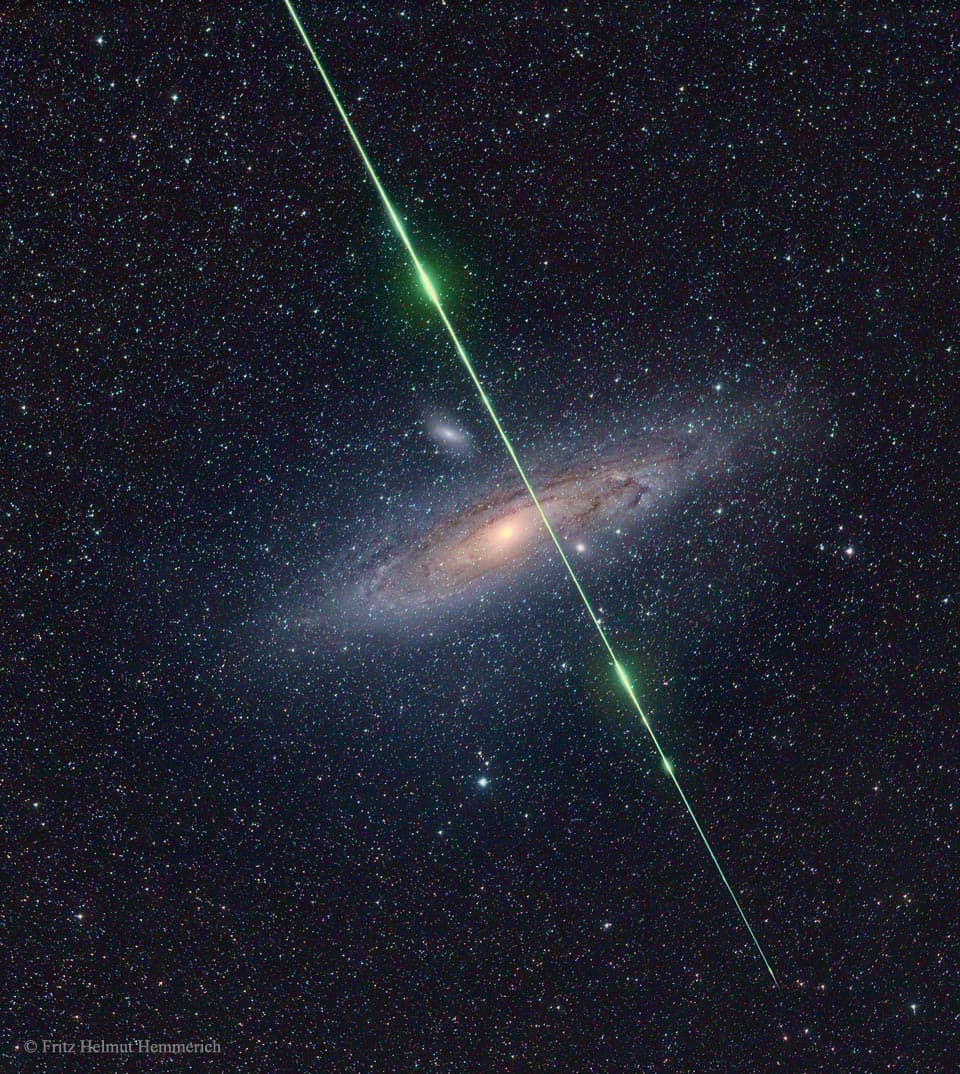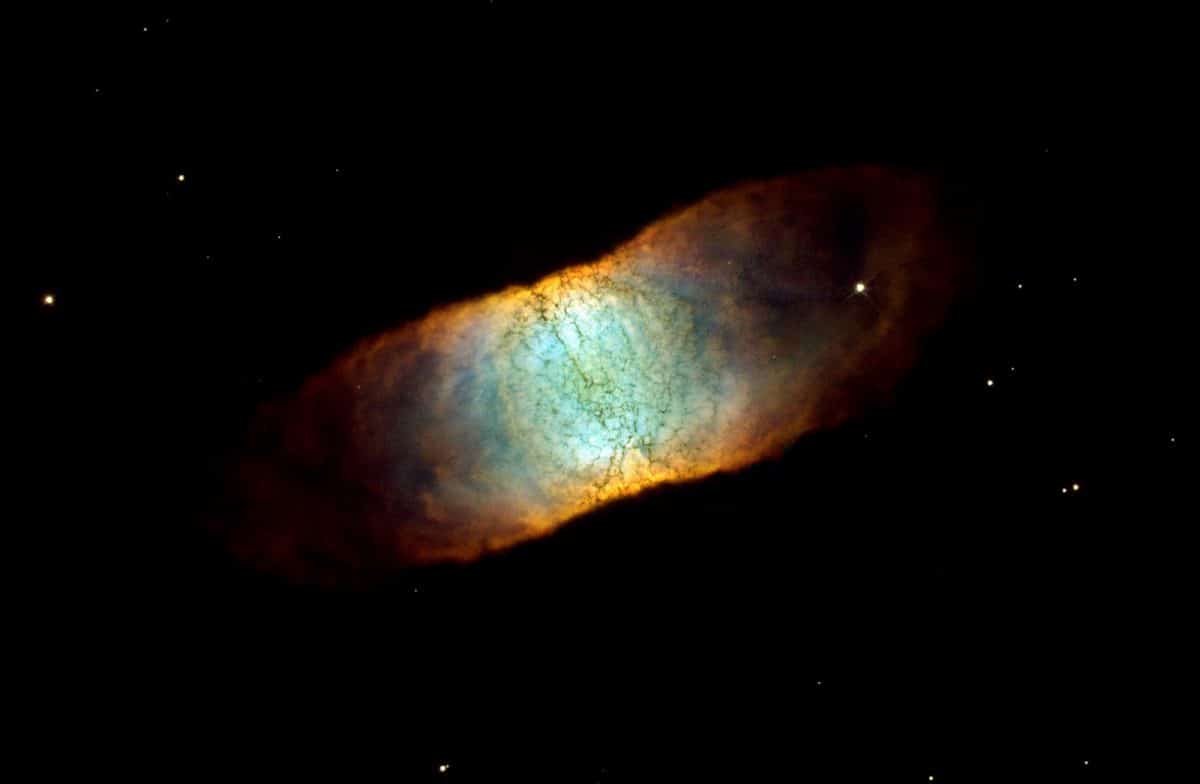Blog
https://www.youtube.com/watch?v=F1VOTKiPEOM
more...What’s that green streak in front of the Andromeda galaxy? A meteor. While photographing the Andromeda galaxy in 2016, near the peak of the Perseid Meteor Shower, a sand-sized rock from deep space crossed right in front of our Milky Way Galaxy‘s far-distant companion. The small meteor took only a fraction of a second to pass through this 10-degree field. The meteor flared several times while braking violently upon entering Earth’s atmosphere. The green color was created, at least in part, by the meteor’s gas glowing as it vaporized. Although the exposure was timed to catch a Perseids meteor, the orientation of the imaged streak seems a better match to a meteor from the Southern Delta Aquariids, a meteor shower that peaked a few weeks earlier. Not coincidentally, the Perseid Meteor Shower peaks again tonight.
more...Patrick Bruce Metheny (/məˈθiːni/ mə-THEE-nee; born August 12, 1954) is an American jazz guitarist and composer.
He is the leader of the Pat Metheny Group and is also involved in duets, solo works, and other side projects. His style incorporates elements of progressive and contemporary jazz, Latin jazz, and jazz fusion. Metheny has three gold albums and 20 Grammy Awards and is the only person to win Grammys in ten different categories. He is the brother of jazz flugelhornist Mike Metheny.
When Pat Metheny Group (ECM, 1978) was released, the Group was a quartet comprising, besides Metheny, Danny Gottlieb on drums, Mark Egan on bass, and Lyle Mays on piano, autoharp and synthesizer. All but Egan had played on Metheny’s album Watercolors (ECM, 1977), recorded a year before the first Group album.
The long list of his collaborators includes Lyle Mays, Bill Frisell, Billy Higgins, Brad Mehldau, Charlie Haden, Chick Corea, Dave Holland, Dewey Redman, Eberhard Weber, Herbie Hancock, Jack DeJohnette, Jaco Pastorius, John Scofield, Joni Mitchell, Joshua Redman, Marc Johnson, Michael Brecker, Mick Goodrick, Roy Haynes, Steve Swallow, and Tony Williams.
https://www.youtube.com/watch?v=v0DgOXYg3ZI
more...Jonathan David Samuel Jones (October 7, 1911 – September 3, 1985) was an American jazz drummer. A band leader and pioneer in jazz percussion, Jones anchored the Count Basie Orchestra rhythm section from 1934 to 1948. He was sometimes known as Papa Jo Jones to distinguish him from younger drummer Philly Joe Jones.
Born in Chicago, Illinois, Jones moved to Alabama, where he learned to play several instruments, including saxophone, piano, and drums. He worked as a drummer and tap-dancer at carnival shows until joining Walter Page‘s band, the Blue Devils in Oklahoma City in the late 1920s. He recorded with trumpeter Lloyd Hunter‘s Serenaders in 1931, and later joined pianist Count Basie‘s band in 1934. Jones, Basie, guitarist Freddie Green and bassist Walter Page were sometimes billed as an “All-American Rhythm section,” an ideal team. Jones took a brief break for two years when he was in the military, but he remained with Basie until 1948. He participated in the Jazz at the Philharmonic concert series.
He was one of the first drummers to promote the use of brushes on drums and shifting the role of timekeeping from the bass drum to the hi-hatcymbal. Jones had a major influence on later drummers such as Buddy Rich, Kenny Clarke, Roy Haynes, Max Roach, and Louie Bellson. He also starred in several films, most notably the musical short Jammin’ the Blues (1944).
more...Sami from Norway
more...https://www.youtube.com/watch?v=hh_IccWWRtY
more...Although there are no seasons in space, this cosmic vista invokes thoughts of a frosty winter landscape. It is, in fact, a region called NGC 6357 where radiation from hot, young stars is energizing the cooler gas in the cloud that surrounds them. This composite image contains X-ray data from NASA’s Chandra X-ray Observatory and the ROSAT telescope (purple), infrared data from NASA’s Spitzer Space Telescope (orange), and optical data from the SuperCosmos Sky Survey (blue) made by the United Kingdom Infrared Telescope. Located in our galaxy about 5,500 light years from Earth, NGC 6357 is actually a “cluster of clusters,” containing at least three clusters of young stars, including many hot, massive, luminous stars. The X-rays from Chandra and ROSAT reveal hundreds of point sources, which are the young stars in NGC 6357, as well as diffuse X-ray emission from hot gas. There are bubbles, or cavities, that have been created by radiation and material blowing away from the surfaces of massive stars, plus supernova explosions. Astronomers call NGC 6357 and other objects like it “HII” (pronounced “H-two”) regions. An HII region is created when the radiation from hot, young stars strips away the electrons from neutral hydrogen atoms in the surrounding gas to form clouds of ionized hydrogen, which is denoted scientifically as “HII”. Researchers use Chandra to study NGC 6357 and similar objects because young stars are bright in X-rays. Also, X-rays can penetrate the shrouds of gas and dust surrounding these infant stars, allowing astronomers to see details of star birth that would be otherwise missed.
more...Thetakudi Harihara Vinayakram (born 11 August 1942), also known as Vikku Vinayakram, is a Grammy Award–winning Indian percussionist. He plays Carnatic music with the ghatam, an earthen pot, and is credited with popularising the ghatam.
He was awarded the Padma Shri, given by Government of India in 2002, and later the 2012 Sangeet Natak Akademi Fellowship, the highest honour in the performing arts conferred by the Sangeet Natak Akademi, India’s National Academy for Music, Dance and Drama. Finally he was awarded the Padma Bhushan in 2014.
Vinayakram was born to Kalaimaamani T. R. Harihara Sharma, a musician and teacher. He took up playing at a very young age.
more...Eldridge Freeman (August 11, 1921 – 2006), also known as “Buzz” Freeman or “Bruz” Freeman, was an American jazz drummer.
Born in Chicago, with his brothers, guitarist George Freeman and tenor saxophonist Von Freeman, he played for several years in the house band at the Pershing Hotel. He was also the uncle of Chico Freeman, the son of Von Freeman.
In 1950, he was a member of John Young‘s trio with LeRoy Jackson on bass, and recorded with Young’s orchestra backing vocalist Lurlean Hunter.
In the mid-1950s, he was a member of the Hampton Hawes Quartet, with Red Mitchell and Jim Hall, and with line-ups led by Herb Geller. In 1950, with his brothers George and Von (originally misidentified as Claude McLin), LeRoy Jackson, and Chris Anderson, he played with Charlie Parker shortly before his death, at a jam session recorded at Bird’s apartment which was released in 1960 by Savoy.
more...https://www.youtube.com/watch?v=8C9a3qTswV0&list=RD8C9a3qTswV0&start_radio=1
more...World Music on Flamenco Fridays with one of major influences of Flamenco music.
Francisco de Asís Tárrega y Eixea (21 November 1852 – 15 December 1909) was a Spanish composer and classical guitarist of the Romanticperiod. He is known for such pieces as Recuerdos de la Alhambra. He is often called “the father of classical guitar” and is considered one of the greatest guitarists of all time.
Tárrega was born on 21 November 1852, in Villarreal, Province of Castellón, Spain. It is said that Francisco’s father played flamenco and several other music styles on his guitar; when his father was away working as a watchman at the Convent of San Pascual, Francisco would take his father’s guitar and attempt to make the beautiful sounds he had heard. Francisco’s nickname as a child was “Quiquet”.
https://www.youtube.com/watch?v=y_goHl-GuNk&t=0s&index=6&list=PLF183036912DCA301
more...
August 10-1984
Fridolijn’s musical career started at the age of 18 with the record contract she brought in at the Blaricum Soundpush Studios. There she worked together with top producer Jaap Eggermont for two years on her debut album. A huge school, which has played a part in the success of her own jazz / pop band Finn Silver.
With this she released a beautiful album in 2011, which stood at the top of the Dutch and international jazz charts for weeks. She toured through the Netherlands and Japan, and has done major jazz festivals such as North Sea Jazz in Rotterdam and Billboard Live in Tokyo. In 2015 she released her first solo album, called ‘Catching Currents’. An album with own written songs that has received rave reviews in the music magazine Jazzism.
Charles H. “Chuck” Israels (born August 10, 1936) is a composer, arranger, and bassist who is best known for his work with the Bill Evans Trio. He has also worked with Billie Holiday, Benny Goodman, Coleman Hawkins, Stan Getz, Herbie Hancock, J. J. Johnson, John Coltrane, and Judy Collins
Born in New York City, Chuck Israels was raised in a musical family which moved to Cleveland, Ohio when he was 10. His stepfather Mordecai Bauman was a singer who performed extensively with composer Hanns Eisler. He, along with Israel’s mother, Irma Commanday, created a home environment in which music was a part of normal daily activity. Paul Robeson, Pete Seeger, and The Weavers were visitors to the Bauman home. In 1948, the appearance of Louis Armstrong‘s All Stars in a concert series produced by his parents gave him his first opportunity to meet and hear jazz musicians.
more...Gertrude E. “Trudy” Pitts (August 10, 1932 – December 19, 2010) was an American soul jazz keyboardist from Philadelphia, Pennsylvania. She was known primarily for playing the Hammond B3 organ.
Trained as a musician and a music educator, Pitts studied at the Philadelphia Musical Academy, Temple University and Juilliard, as well as other institutions. Early work experience included a position as an assistant to the pianist in the Tony Award-winning musical Raisin.
At the end of the musical’s tour, she was encouraged by her husband (who had worked with Shirley Scott as a drummer) to continue developing her repertoire.
In 1967, the Boston Globe printed a piece calling her a rising star and complimented her drawbar variation, vibrato shadings, and bass pedal work. Her husband, William Theodore Carney II (born 1925), aka “Mr. C.”, often joined her on the drums.
Trudy Pitts eventually went on to play with Ben Webster, Gene Ammons, and Sonny Stitt.[1] She recorded four albums for Prestige Records, appearing with Willis Jackson among others. In 1999, a compilation album of several records was released as Legends of Acid Jazz, Trudy Pitts & Pat Martino. Recent festival appearances include the 11th Annual Mary Lou Williams Women in Jazz Festival at the Kennedy Center in Washington, D.C., in May 2006. On September 15, 2006, Pitts was the first jazz artist play a concert on Philadelphia’s Kimmel Center’s 7,000 pipe organ, “taking the medium to a whole new level”.
more...Although not formally introduced to the santoor [also known as santur] until 1985, when he was 12 years old, Rahul Sharma had already demonstrated his talent by playing and composing on the harmonium, and on a cheap keyboard that his dad had brought back from Japan.
more...https://www.youtube.com/watch?v=kVJn3K6AVuM
more...Andile Yenana is a South African pianist. He made an indelible mark by switching from teaching to studying jazz. He has produced and worked with many South African as well as international artists.
Born in 1968 in King William’s Town, Andile’s love for music was triggered at an early age. He grew up in a household where music was really loved. His father, Felix Thamsanqa Yenana, had a huge collection of music, ranging from jazz to Motown, and other forms of urban black music and this had a huge influence in Andile’s life. Andile obtained a teaching diploma from the University of Fort Hare in South Africa’s Eastern Cape Province[citation needed] before taking up music studies under Darius Brubeck at the University of Natal‘s School of Jazz and Popular Music It was here that he became friends with saxophonist Zim Ngqawana and trumpeter Feya Faku.
more...More Posts
- Daily Roots with Cornell Campbell
- The Cosmos with the Antares
- Charlie Watts Day
- Ahmed Jamal Day
- World Music with Mamady Keita
- Daily Roots with Leroy Smart
- The Cosmos with IC 5332
- Leon “Ndugu” Chancler Day
- James Cotton Day
- Willie Dixon Day
- World Music with Music Maya Aj
- Daily Roots with Horace Andy
- The Cosmos with Trapezium Cluster
- Stanley Clarke Day
- Andrew Hill Day
- World Music with Nico Kasanda
- Daily Roots with Hortense Ellis
- The Cosmos with M24
- Gilberto Gil Day
- Julian Priester Day



